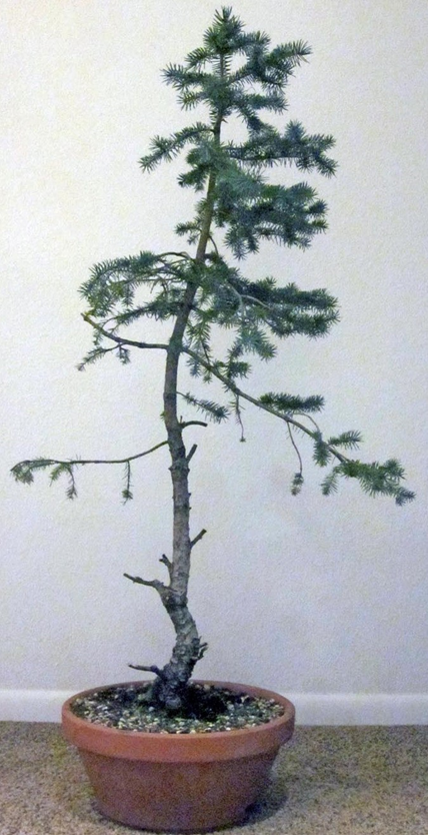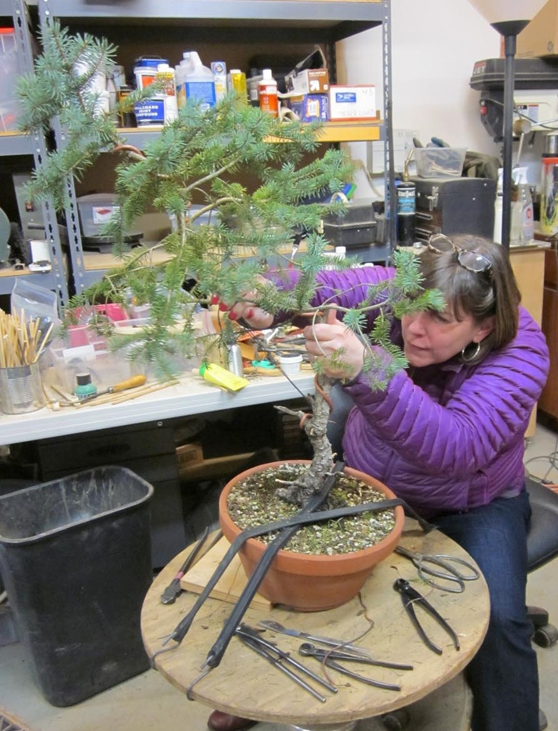Now that fall has come in full force and we are surging into winter, it may seem that because we have no leaves that we have no way of determining the strength of our trees. In reality, we have all the information that we need tied up in the buds that are already set for next year. I don’t think that it was until I started doing bonsai that I realized that all trees set their buds for the next year not in the spring when they elongate, but throughout the year. If you have ever pinched a spruce tree you can already feel next year’s terminal bud in that brand new, bright green growth. If we make a close examination of the winter buds on each branch, we can tell exactly how strong it is, where we can prune, and exactly what to expect come next spring.
First off, any branching that we see at this point is a result of the strength that a tree had last spring, and on through the summer. It is not a direct reflection of the current strength and health of an individual branch or tree at this time. For instance, a tree could have grown poorly in spring, but you adjusted your water balance, fertilizer, etc… and the tree recovered and became strong. That will be demonstrated by robust buds. Conversely, a tree could have grown strongly in the spring, but then ran into problems later in the year. That would be shown in strong branches, but weak new buds right now. As we prune, wire, and otherwise care for our trees, evaluating bud strength becomes crucial. Here is a list of points to consider, in rank of importance;
1. Number of buds at one location
2. Total number of buds on a branch
3. Length of the bud
4. Diameter of the bud
5. Color of the bud
I have quite a few examples to walk you through for both deciduous and coniferous trees. Keep in mind that we can’t cover all trees, and that species vary wildly in their behavior. But these principles are pretty consistent. Take a quick look at a tree. Pines would be the most obvious if you have one. The buds will tend to be very strong at the top and weaker as you work down the tree and into the interior. A strong branch will have multiple buds in a single location, and they will be large.
Think of bud strength as total mass of the buds that are present. The more bud mass you have, the stronger the branch. One branch may have its strength distributed over two medium buds and another branch concentrated in one super large bud, but the branches are nearly equal in strength. The buds may not be that much larger than on other parts of the tree, but if you have 4-5 in one spot, it’s very strong. The tree is telling you that it feels so good about that branch that it has invested a lot of resources in that one spot.
Our goal in bonsai is to end up with the same amounts of resources, the same level of growth on every single branch. Now is not the time to mess with that balance – we have techniques for that in the growing season. But we do have a great insight into what is going on right now.
Let’s look at a Japanese Red Pine. The first photo shows an extremely strong branch tip at the top of the tree. It has nice, large, multiple buds. They are nicely pointed. The second photo shows a medium strength branch, with a bud the same size as the strong branch, but there is only one present. Ideally, we would have two buds at any one location. The third photo shows a relatively weak pine bud. It is small and rounder in appearance. This is not the branch that you want to make into a new leader or to use for grafting. But is still viable and still useful.
Red pine, strong bud (left), Red pine, medium bud (right)
Red pine, weak bud (left), Subalpine fir, weak bud (right)
Next up we have the Subalpine Fir that we worked on at the last club Zoom meeting in October. The buds on this tree are small and relatively weak. The foliage is strong, so we are OK, but we know that we are going to have to pay particular attention to the winter care and spring growth on this tree to get it strong again.
Compare this with the stronger buds of a different subalpine fir. The buds are larger and there are two. Then we come to the interesting case of the super strong buds in the next photo. Strong buds on any true fir will make a sort of hammerhead effect of several buds massing together as you see here. But notice that the foliage here is shorter, from the same tree. It did not growth as strong in the initial push last year, but has made up for it through the summer and fall and set itself up nicely for next year
Subalpine fir, strong bud (left), Subalpine fir, super bud (right)
And just in case you think I was going to leave the deciduous trees high and dry, here ya go. Let’s look at a standard Japanese maple. On this single branch, we have three different strengths in the buds. Notice the very robust buds at the tip. We are in great shape there. If we are in refinement (which this tree is) then this bud may be too strong for our needs. The buds on the far right are actually a pair, and are of medium strength with a nice short internode. On the middle bud, you can see where a shoot was pruned back during the summer, dying back to the next node and producing a single weak bud. We can still use this bud if desired, but it demonstrates well how the strength is distributed on the branch.
Japanese maple, buds of varying strength (left), Garry oak, very strong cluster of buds (right)
Next up we have a Garry Oak with a VERY strong cluster of buds for next year. I can hardly wait as this tree is still in development.
Styrax, green bud
I also wanted to show you a Styrax as the buds are green. Just about every year I am fooled into thinking that it has started to grow prematurely, but this is just it’s appearance. It will stay just like this very reliably until next March or so.
We also have a European Beech for you with medium strength buds. By no coincidence, this is from the middle height of the tree. Note how the beech may keep it’s leaves through the winter to protect its buds. The next photo shows weak interior buds. You can’t tell easily, but these are about a third of the size of the previous photo. The one on the right is healthy, but not vigorous. The one on the left is very weak and at risk of perishing. The color is great though. Be careful of small stubs as they may not have a viable bud on the end. Just because there is a point doesn’t mean it will elongate in the spring.
Beech, medium strength bud (left), Beech, weak interior buds (right)
Here we have a coastal Douglas Fir. This tree has grown into a rock star the last few years, mostly because of Ryan Neil’s mid-summer pruning technique. Each shoot was pruned as short as possible, while still leaving two tiny, immature buds on each branchlet. Those minute buds have now matured into full blown buds, pumped with energy to be released next spring. Even though it was cut back in the summer, many branches still produced three strong buds. Medium areas typically develop one bud where I cut back to (I cut just ahead of the second bud on the branch, making the new tip) and usually one somewhere behind it.
Doug fir, triple buds (left), Doug fir, medium buds (right)
In the last photo, we see where I was able to cut all the way back to the base of the branch, leaving a bit of foliage, and ending up with a pair of buds. This may seem counter-productive, as it is would seem that it puts me right back where I started the season. However, in this instance, I now have two branches instead of one in that location, and I have kept the tree smaller, which believe me, is the challenge with this tree.
Doug fir, back buds (left), Engelmann spruce, no bud (right)
Last up we have an Engelmann spruce. This is “Liberace” for those interested. This tree was pinched last spring, as the buds emerged. Pinched shoots on native spruces do not usually produce a bud at the pinch site, as confirmed in this photo. However, the foliage is still strong and contributing to the energy of the tree, so don’t cut it off. It just will not produce growth next spring. Compare that to the last photo where we have a very strong shoot, with the new buds nearly hidden in the needle mass, but they are there.
Engelmann spruce, buds
I hope this quick lesson helps confirm the state of health of your trees and gives you a road map of their care for the upcoming seasons.
Scott














